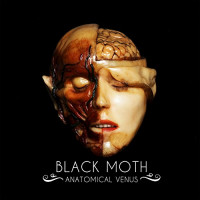Being a fan of doom metal, I’ve been aware of Black Moth and their music for some time now. I’d always found them to be a worthy addition to a pretty well-populated scene, but they had never quite had anything to elevate them above their peers. The certainly weren’t the heaviest, they weren’t the most aggressive, they didn’t set themselves apart with their live shows...you get the picture.
This, the band’s third album, comes a full 3 1/2 years after sophomore effort ‘Condemned to Hope’ and sits comfortably with their previous discography, yet feels quite different; and I’ll explain why. The fundamental component parts remain the same: a doomy, stoner-rock 5-piece, with vocals provided (somewhat unusually for the scene) by frontwoman Harriet Bevan - with a healthy dose of bluesy, classic rock undertones. All very enjoyable, but has felt a little pedestrian for me in the past, I must admit. So it’s come as a very pleasant surprise to me how engaging this record feels.
Album opener ‘Istra’, works as a pretty decent case study for the album, actually. It begins with a simple, yet ominous picking pattern, before the real business of the riffing kicks in - and kick, it does. Before the one minute mark, Bevan’s vocals arrive, soaring over the steady, thick, rumbling riff. Shortly after, a significant switch in time signature and a verse section (that sounds briefly very similar to Oasis ‘The Turning’, believe it or not) before the heavy overdrive and riff drop back in to devastating effect. All told, a statement of intent of an opening track. What’s more; there are plenty of these across the album, yet it doesn’t rely on them exclusively. There are Rated R era QOTSA-influenced, slinky and sleazy riffs (Buried Hoards), a Maiden-esque metal gallop in ‘A Lover’s Hate’ and genuine rock ‘n’ roll swagger and sass throughout.
On the evidence of the first 2 records, if these songs had been recorded by Black Moth in the past, it would likely have been done so with rather less variation, confidence and conviction. This album though, finds the band in superb musical form. The rhythm section feels tight and powerful throughout the many time changes, while the guitar work of Jim Swainston and Nico Carew is borderline heroic, frankly. Towering riffs, visceral solos and they don’t shy away from Thin Lizzy-style harmonies, either. They’ll not be to everyone’s palate, but it certainly doesn’t feel incongruous.
It would be remiss not to take a little time to talk about the production, which is absolutely spot on. Every song sounds huge, with each element coming to the fore where necessary but in the main, driving the overall sound - which reminds me very much of The Sword’s debut, ‘Age of Winters’, in that it feels heavy, thick, yet punchy and distinct. Not easy to do without losing the record’s innate doom/stoner inflection. Production credits go to Andy Hawkins and the record was recorded in the band’s native Leeds, which may go some way to explaining how comfortable and in control of their sound the band feel throughout the record.
I was entirely expecting to be very ‘OK’ with this record, but I’m delighted to say that it demands more attention than that. Even if it doesn’t quite hit people’s end of year lists, Black Moth are in good shape for a ‘most improved’ accolade. Overall, this isn’t anything groundbreaking, but what it is, is comfortably the best version of Black Moth we’ve heard yet.
